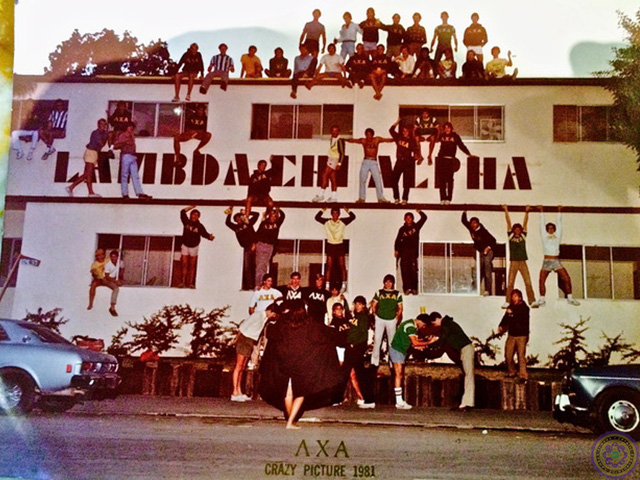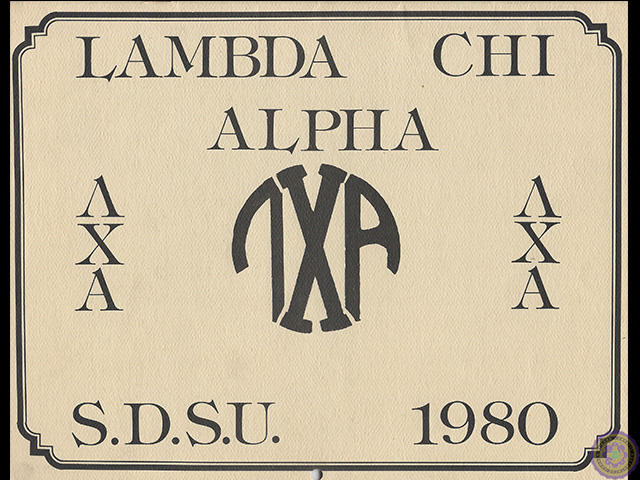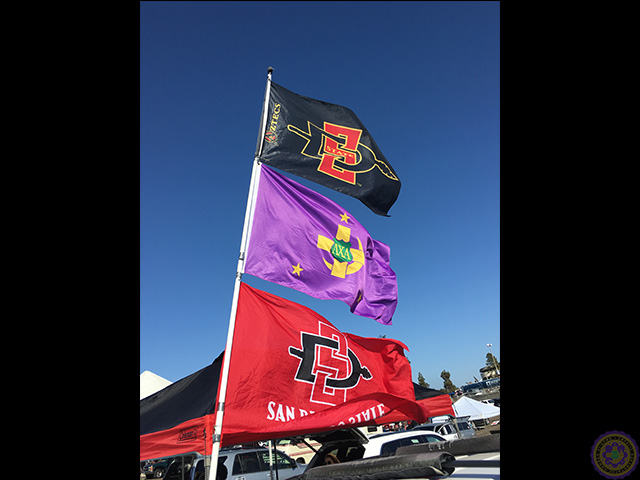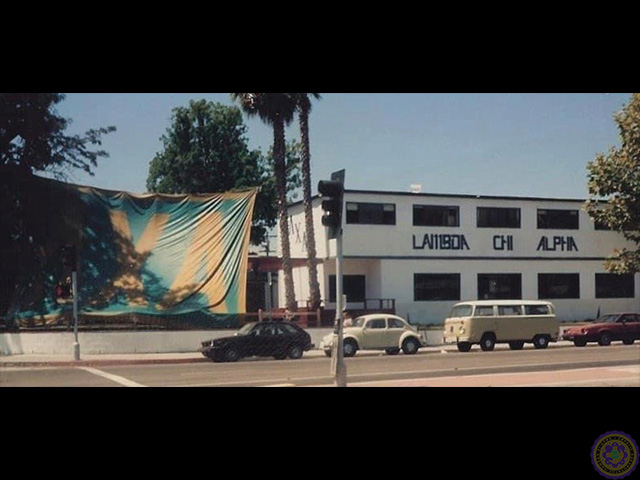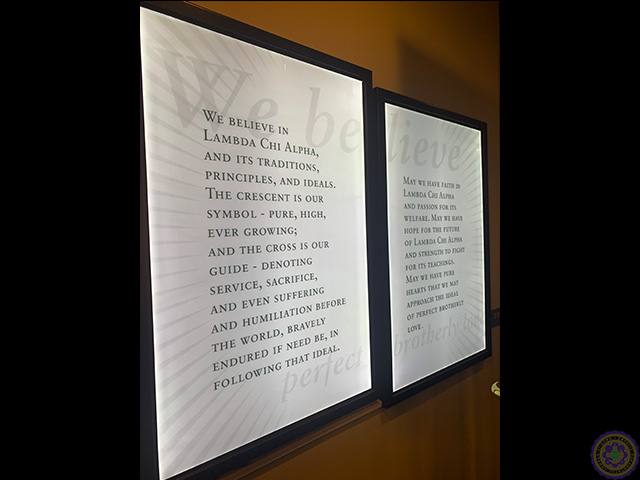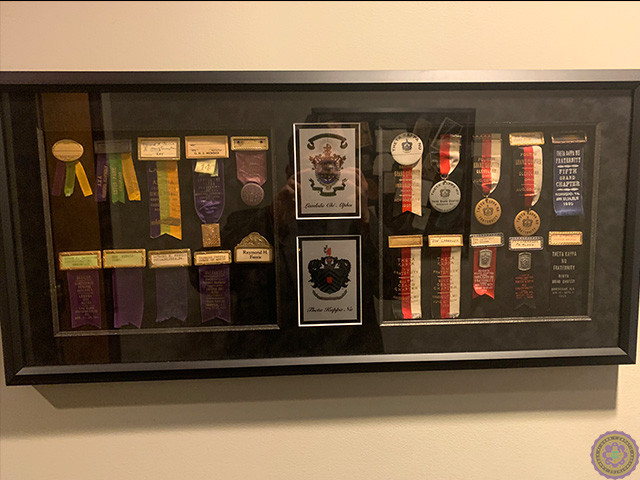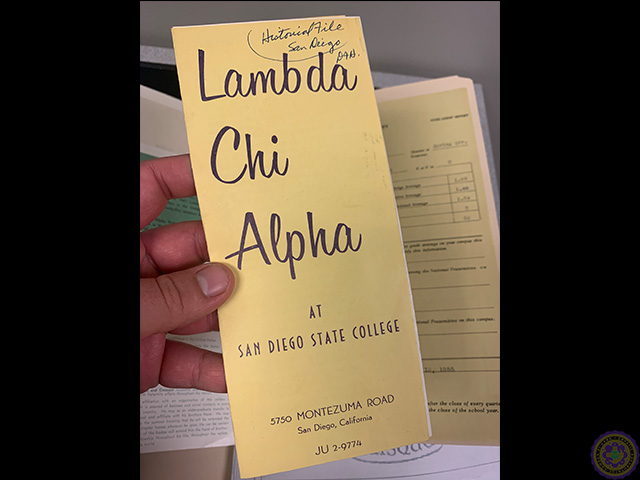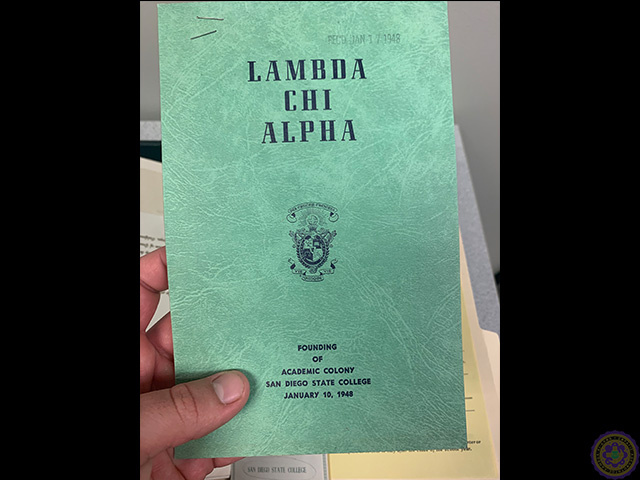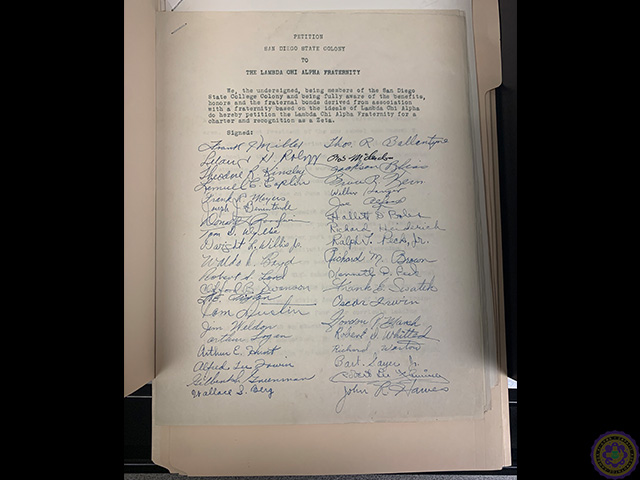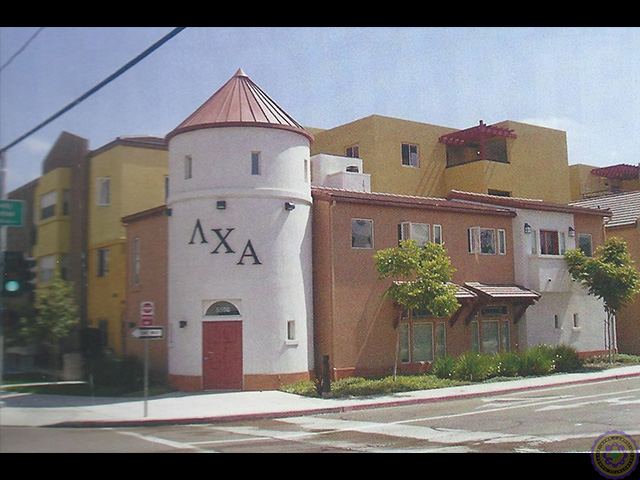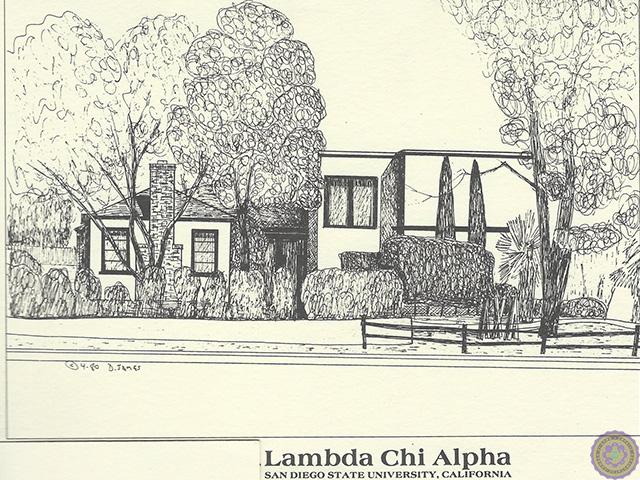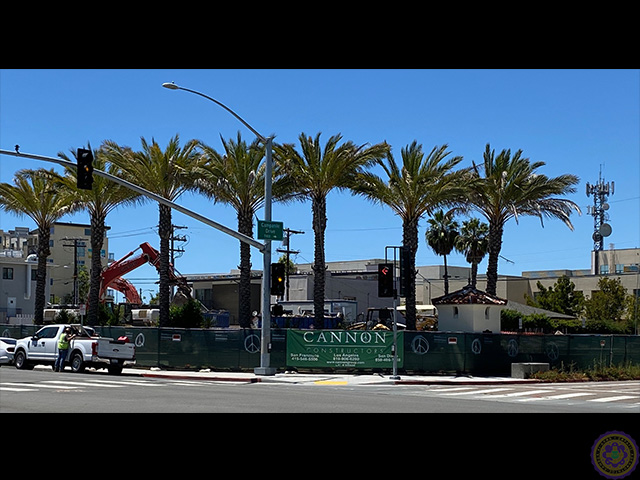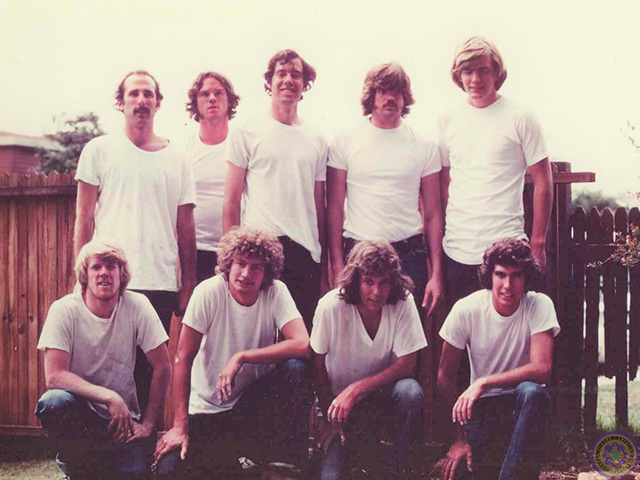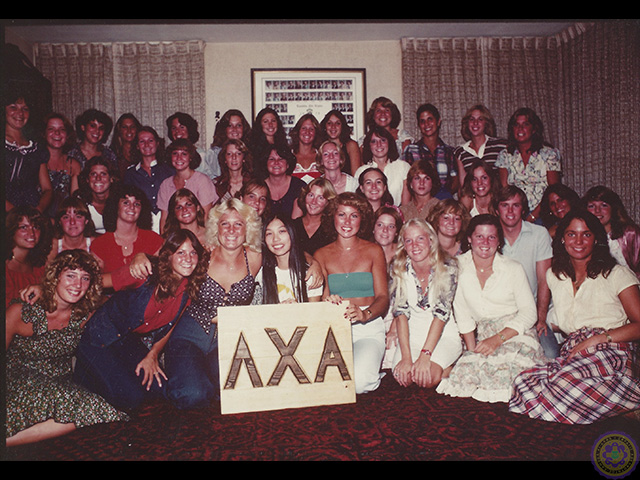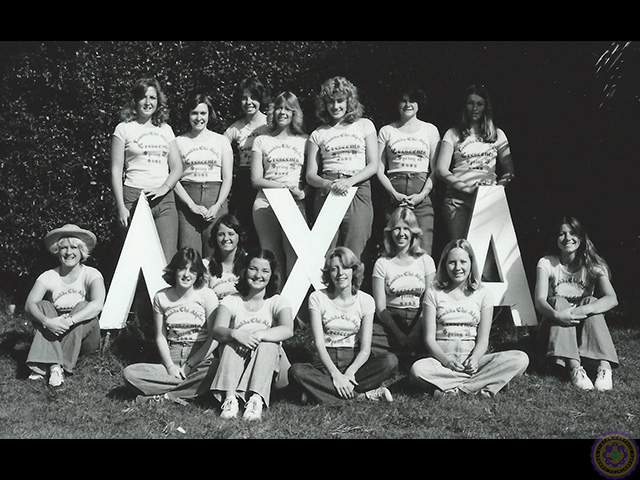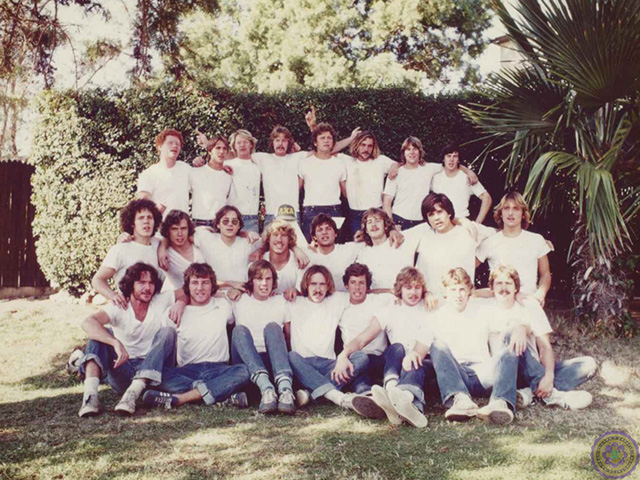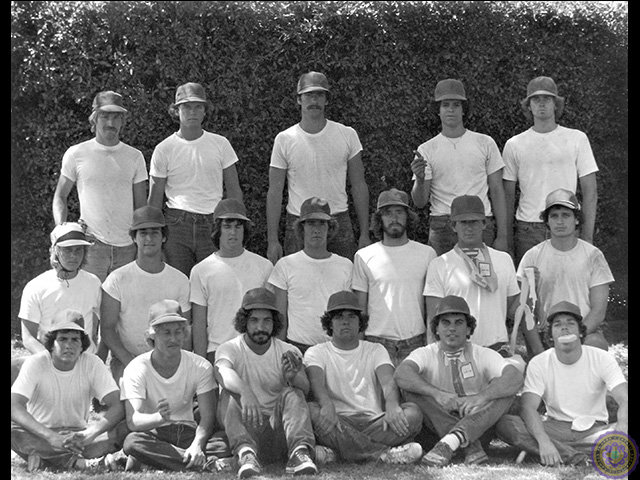DELTA-KAPPA LOCAL HISTORY
This historical overview was taken from The Zeta Piper – Lambda Chi Alpha Spring 1990 Edition.
IN THE BEGINNING
by Wallace S. Berg, Zeta-Pi #8
In the beginning there were four part-time postal employees counting pennies and sharing the last gallon of gas to get to school or work. What one had they all had, and at times, that was precious little. These four were veterans, recently discharged and going to school under the G.I. Bill. Frank J. Miller was the oldest, at about 27 and because of his age and wisdom, became the first High Alpha.
Gilbert Greenman, Wallace Berg and Robert Flemning completed the foursome. The way it all started was around an apple crate table at what was then known as Aztec Terrace. The Terrace was located at the mouth of Mission Valley and Pacific Highway. The housing was modified, tar-paper barracks made into five-unit apartments. I never will forget the walls, between the units. If your neighbor was brushing his teeth you could count the strokes, this of course, made for real togetherness.
Anyway, to get on with the story, when these stalwarts got off work around 10 or 11 every night, one of the wives would always have a pot of coffee ready and we'd gather to tell war. stories, lies or study (usually not much of the latter). Sometimes to break the monotony of poverty, we'd plan elaborate bank jobs and argue about the size of the yacht we should buy. At that time there were few national fraternities on campus and "State" only had an enrollment of about 3800. On two or three occasions during the summer of '47, the subject of fraternities came up. Someone said, "why don't we start one?"
I think that our problem was we had too much free time on our hands! We all either had young babies, or had pregnant wives, worked full-time and of course carried a full load at school, a couple of us even had second jobs.
How does one start a fraternity? The places we started was with alumni advisors, Robert Hamilton and Raymond Hughes. These alumni provided. the encouragement and advice to get the project started. We needed a place to meet and an alumnus by the name of Lawrence A. Kuerbis solved our problem. He owned a furniture store on 9th or 10th Avenue just off Broadway, our first meeting was held there one night in October after we finished work at the main post office. We shortly elected our first officers, with Father Miller as High Alpha. Our original group of four soon became eighteen and our colony was born. The date, January 10, 1948. The original group of initiates were:
Class of 1948
Lemuel Carlos Coplin
Louis Edward Tipton
Class of 1949
Russel Dean Hill
Frank Joseph Miller
Theodore R. Kinsley
Leland Harold Roloff
Class of 1950
Thomas R. Ballantyne Jr.
Richard L. Heidrick
Wallace S. Berg
Frank R. Meyers
Waldo D. Boyd
Robert D. Stockton
Jackson D. Bliss
Class of 1951
Robert L. Flemning
Bernard L. McDermott
Wilbur L. Hanger
Curtis E. Williams
Alfred L. Irwin
At that time, Lambda Chi was just getting a foothold in Southern California, there being only a chapter at U.C.L.A. (Epsilon-Sigma) and a colony at U.S.C. We had our initiation ceremonies at the then swanky Imig Manor Hotel. The ceremonies were performed by a combined team from the Los Angeles schools. I remember that we were in a panic to get on with the business of growth, to grow we had to be a colony so there was considerable pressure to become a colony in time for the spring rush season.
As a colony, we pledged 35 men out of a total of 228 men pledged by all fraternities on campus, not bad for a bunch of beginners, and of course, the national was duly impressed. Considerable credit must be reserved for those other alumni that helped in countless and forgotten ways to make our endeavor successful, some of these were: Merrel Taylor, Robert Hamilton, Ray Hughes and Dr. Roy Cameron, and of course, there was the highly motivated Bernard R. Balch, traveling secretary.
It is interesting to note that this first group of pledges were of a different composition than the original group, most of them were single and without families. If there is a fraternity, there has to be a fraternity house! Where does a fraternity, now 53 strong get a fraternity house? It does take some fancy footwork, especially when your bank account only reflects your dues income. Remember those mid-night sessions when we planned all sorts of escapades? The master plan that evolved was simple, rent one and have the pledges pay board and room to the fraternity and from that we paid the monthly rent. Our first house was a commercial building on El Cajon Boulevard that had been 'built to house a do-it-yourself laundry. It was at the intersection of the main street that went straight to the campus.
I can't remember all the social activities that we had except that we tried to have at least one major activity for the entire fraternity each month, sometimes these coincided with a school function. Some of the activities were parties at Borrego, and Warner Hot Springs, beer and picnic parties at an alumni's cabin at Alpine, taco feeds in Old Town, beach parties and of course the big bash each year in Los Angeles. Twice, before we all went our separate ways, we got together with two Los Angeles chapters and had a tri-chapter dance at the Miramar Hotel in Santa Monica. That was quite an event with about three hundred people attending. Our wives and girlfriends stayed at different sorority houses and we of course stayed at fraternity houses.
Perhaps a few more words regarding the birthing of Zeta-Pi might be in order. At that time, San Diego State was a college and the largest institution of higher education south of Los Angeles. In 1950 the enrollment finally broke the 5000 barrier, something of a milestone. Prior to our becoming a colony there were only four national fraternities, those were Theta-Chi (47) followed by Sigma-Phi Epsilon, Kappa Sigma, and Delta Sigma Pi; there were no national sororities. Our coming on campus was an event. We had a three-day installation program that began with an informal smoker or stag party on the evening of 8th October, 1948.
On the morning of the 9th, the actual installation and initiation began with a break for lunch. The initiation was completed about 4 in the afternoon. The pledging and 1st degree were conferred at the First Presbyterian Church in downtown San Diego, we had lunch at Vallee's in Balboa Park. The three honored guests were Dr. Thomas Law Coyle, · Lawrence A. Kuerbis and Eugene P. Brown, a faculty member. In the afternoon, we completed the second and third degrees. After a tour of the campus for our guests, we all retired to get ready for a formal dinner dance that evening. The dance was held in the Rose Room at the then famous U.S. Grant Hotel. Over 300 members and guests were in attendance. Thinking back on the event it was very exciting and I find myself wondering how we ever paid for it all. The charter was presented to High Alpha Miller by Grand High Delta Louis Fetterly.
In completing this brief review of those early days I ask the forgiveness of anything I should have mentioned and did not. I should also like to pay my respects to two of the original four who have joined God's fraternity:
Frank Joseph Miller 1988
Gilbert Greenman 1983
The House at 5750 Montezuma Rd was purchased in 1955. At that time it was a 3 bedroom, 1 bath small home on the corner of Montezuma and Campanile. Around 1959 a chapter room and 5 bedrooms were added, along with a bar and showers upstairs. In 1977 the Housing Corp donated a Jacuzzi to the chapter, which was installed by brother Jim Ward, ZP 605. In 2003, the Housing Corp did an exchange with the SDSU Foundation for a property at 5500 Hardy Ave. That house was sold in 2019, with the proceeds being managed by the current Housing Corp board. Lambda Chi Alpha lost their charter twice, once in 1995, was colonized in 2004, and lost their charter again in 2008.
